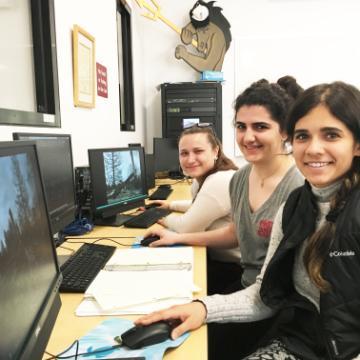Restoring Paradise

On November 8, 2018, a wildfire turned firestorm ripped into the town of Paradise, California. Within just 90 minutes, the town was engulfed. When the fires were extinguished 17 days later, the human and economic tolls were devastating: 85 lives lost, 240 square miles scorched, 18,800 structures destroyed, $16.5 billion in damages. The townspeople were bowed and heartbroken, but not defeated; residents quickly regrouped to plan rebuilding.
On February 12 and 22 of this year, three civil engineering seniors, Sedona Leza, Karin Komshian, and Brianna Eremita, joined the resilient citizens at Paradise town planning meetings. The students were moved by the suffering caused by the disaster. The team (advised by civil engineering Associate Professor Reynaud Serrette, founder of the Light Gauge Steel Research Group) chose to take on the challenge of modeling a house to better mitigate fire damage and to research municipal strategies to minimize future loss.
When the team drove into Paradise the first time, they were shocked by the devastation. “We’d been reading articles and looking at pictures online, but when you see the rubble, it is so emotionally heavy,” Sedona said. “The scale of destruction was incomprehensible. The only things left standing were metal or masonry.”
At the planning meetings, the team got a feel for how the residents were planning to rebuild. “We wanted to see if there was an opportunity to put in ideas or help,” Karin said. “We learned the town is still looking to build with timber, but wood fuels a fire. Firefighters I spoke with said the fire spread so quickly because it jumped from house to house, becoming an urban firestorm. Timber construction did nothing to constrain the spread, so we’re proposing using cold-formed steel for construction instead. It’s a bit more expensive, but the fire resiliency makes it more affordable in the long run.”
In addition to designing with fire-resistant building materials, the team is also investigating how homes could be better sealed against an external fire. “There’s a tradeoff, though,” Brianna explained. “If a fire starts inside, sealing will make it worse. Balancing both scenarios is a challenge in the construction phase.” They are also looking at ways to combat the problem of pine needles and debris collecting on roofs and acting as kindling during a fire.
Beyond home design and construction modeling, the civil engineers are also making recommendations for defensible space and homeowner maintenance. Even more, they are exploring the feasibility of an early-action system that would release water in the area surrounding Paradise to saturate potential fuel and slow wildfire progression as it approaches town. Sedona described the team’s thinking: “We’re looking at creating a buffer zone around the town—parkland or community vegetable gardens, or a solar farm—that would minimize vegetation and create a fire break. We have to be cognizant of the town’s perspective, though. They are very concerned that in rebuilding they maintain the feel of the community they love; they don’t want to feel like a suburb of Chico. They are a close-knit community. We want our recommendations to beautify their town and foster a sense of community.”
The team has a deliverable to present a set of recommendations to the town council later this spring. “There are a lot of moving parts to this project,” said Brianna. “We’re learning so much about cold-formed steel construction, building codes, power line safety risk, municipal planning, evacuation routes, and more. Some of our recommendations will be very detailed, others will be presented as considerations, not fully fleshed out. It’s been challenging, but Dr. Serrette encouraged us to look 10 years into the future, and it is rewarding to help the people of Paradise.”
Sedona, Karin, and Brianna agree that seeing the resilience of the community and witnessing their fighting spirit helps motivate them. “There’s no question this town will rebuild and be better than ever. We’re happy to be able to put our education to use for them in any way we can,” said Karin.
From left: Sedona Leza, Karin Komshian, Brianna Eremita